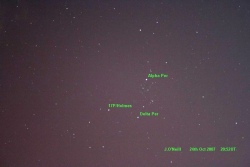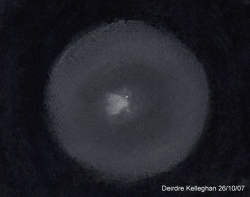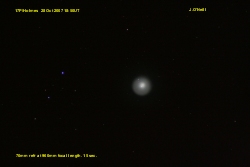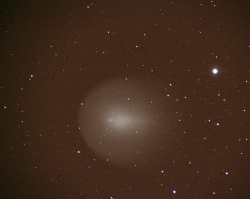COMETS
Images and Accounts of Comets by members:
Comet Lulin 2009 C/2007 N3

The Comet in a bright moonlit sky on 5th March 2009.
Focal length 530mm with 4X10 second exposures.
The green colour of the comet is evident. Imaged by John O'Neill
with a DSLR camera.
Comet 17P/Holmes in outburst late 2007
Reading left to right from top row down
- Image by John O'Neill on 24 Oct 2007. Camera lens focal-length 56mm, a 15 second exposure. With the
naked-eye it looked for all the world like a nova.
- Drawing by Deirdre Kelleghan.
The very bright pin point nucleus, beautiful, almost circular halo.
A fan or delta shape jet of material emanating from the nucleus but contained with the huge circular coma.
The inner ring seemed to be darker and then it blends into the outer brighter diffuse ring.
There seemed to me to be a split or some structure in the material toward the north of the nucleus (south is up).
Done with Watercolor / Pastels/ Conte. Done at 150 power on her telescope. 26 October 2007.
- Image by John O'Neill. 28 Oct 2007. Coma now larger and more diffuse. Details on image.
- Image by John Murphy on 16 Nov 2007. 102mm refractor at 660mm focal-length, 2 x 30 sec.
Comet McNaught C/2006 P1 in Jan. 2007


Photos (details) of Comet McNaught C/2006 P1 by John O'Neill on 5th and 10thJanuary 2007.
DSLR Camera. This comet became a brilliant southern object.
Comet SWAN C/2006 M4 in Oct. 2006
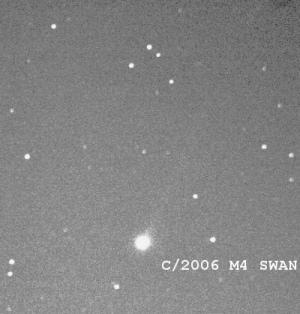
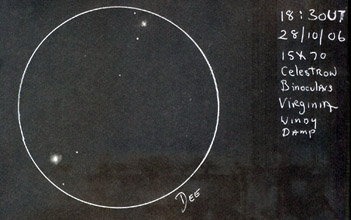
Photo (detail) by John O'Neill on 12th Oct 2006. Imaged with a digital camera using a 60mm refractor
at focal-length 390mm. The faint tail is visible.
Drawing by Deirdre Kelleghan. She drew the Comet and globular cluster M13 on October 28th 2006 at 18:30 UT.
Used 15X70 binoculars at Virginia, Co Cavan.
Comet 73P/Schwassmann-Wachmann in 2006

Never a very bright comet, 73P/Schwassmann-Wachmann passed throught the field of the famous variable
star R Corona Borealis.
Imaged by John O'Neill. 22nd April 2006. 60mm refractor, 355mm focal-length with a digital camera.
Comet Machholz C/2004 Q2 in 2005
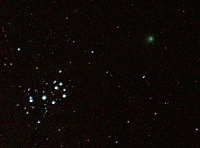
The Comet passes near the M45 Star Cluster (Pleiades or Seven Sisters) on
8th January 2005. The green colour of the comet is evident. Imaged by John O'Neill
with a digital camera (Nikon 4500). 1 minute exposure.
Comet NEAT C/2001 Q4 in 2004
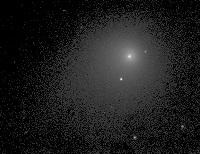
Although never a great comet as some predicted, it was a pretty enough sight
particularly from dark skies. It reached 3rd magnitude at best. Liam Smyth
imaged a close up view through a 20cm Schmidt-Cassegrain 2000mm focal length on 29th May 2004.
Comet Ikeya-Zhang C/2002 C1 in 2002

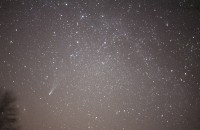

5 minute exposure with Fujichrome 200 on a 135mm focal-length lens.
Some cloud present. Near Kells, Co. Meath. 1 April 2002 21.05 UT.
By John O'Neill
2.5 minute exposure with Fujichrome 200 on a 50mm focal-length lens at f/2.8.
Clear sky. Near Kells, Co. Meath. 7 April 2002 21.44 UT. By John O'Neill
John McConnell made a 8 minute exposure with a 135mm focal-length lens.
200 ASA print film. Passing cloud at left. 17 April 2002 23.30 UT.
Comet LINEAR C/1999 S4 in 2000
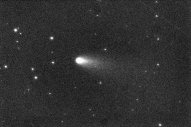
21 July 2000 00.05 UT.
30 sec. exposure with a ST-7 CCD on a 480mm focal-length 70mm refractor.
In Dublin sky glow with a waning gibbous moon. Somewhat hazy sky.
By John O'Neill
Hale-Bopp in 1997
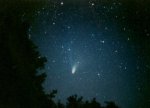
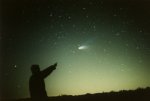
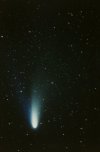
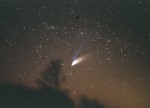
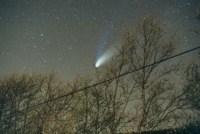
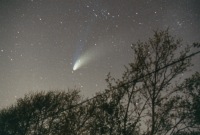
- The Comet among the stars of eastern Cygnus on the morning of 2nd March 1997. Taken
by John O'Neill with a 50mm focal-length lens on a fixed tripod (35 sec., Fujichrome 400).
- John O'Neill pointing out the comet.
The Comet, in Lacerta, on the evening of 8th March 1997. Sky glow from Dublin. Taken with a 50mm focal-length lens
at f1.8.
(40 sec., Ektachrome 400). Courtesy John O'Neill (photo taken by
Angela O'Connell).
- The Comet on the morning of 13th March 1997. Taken by John O'Neill with a 105mm Telephoto Lens.
(5 min., Ektachrome 400).
- The Comet, in Andromeda, on the evening of 31st March 1997. The blue Ion Tail is passing
near the Perseus Double Cluster while the cream Dust Tail curves towards Cassiopeia.
Taken with a 50mm Lens f2.5. (10 min., Ektachrome 400). Film Scanner used (Unprocessed).
Taken by John O'Neill.
- The Comet is just above Gamma Andromedae at 21.30 UT on 3rd April 1997. Messier 34 is to the upper left
of the Comet. Excellent conditions bring out the white dust-tail and the blue ion-tail.
Taken by Brian Noonan with a 50mm focal-length lens at f2.8 (60 sec., Fujicolor Super G Plus 400).
- The Comet at 21.05 UT on 10th April 1997. The bright star in the white dust tail
is Beta Persei or Algol, the famous eclipsing variable. Taken by Brian Noonan with a 50mm
focal-length lens at f2.8 (60 sec., Fujicolor Super G Plus 400).
Top |
Home |
Sky & Gallery

